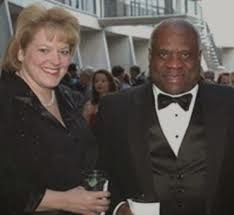The Supreme Court Show its Hand on Gay Marriage and it said Yes: Clarence Pissed Off
The most prominent sign that the Supreme Court is poised to recognize a constitutional right for same-sex couples to marry nationwide came Monday from an unlikely source: conservative Justice Clarence Thomas.
The court is months away from hearing arguments in a landmark caseabout whether states are free to ban such unions. But Thomas said a majority of the justices may have already made up their minds, as reflected by the court’s “indecorous” decision Monday morning allowing same-sex marriages to proceed in Alabama.
“This acquiescence may well be seen as a signal of the Court’s intended resolution of that question,” Thomas wrote in a dissent from the court’s order refusing to stay the weddings. “This is not the proper way to discharge our . . . responsibilities.”
He was joined by one other justice, Antonin Scalia, in saying the court should agree to postpone the weddings until the justices hear the same-sex-marriage case in April and rule by the end of their term in June. Most of the momentum has come from federal court decisions finding state bans unconstitutional. The Supreme Court has been unwilling to put those decisions on hold and make same-sex couples wait to marry. As a result, nearly three in four Americans live in states where gay marriage is currently legal.
As some judges in Alabama resisted the court’s action Monday, refusing to provide marriage licenses, there was fury on the right as well.
“A majority of the Supreme Court has cast disrepute on the impartiality of the Court by refusing to follow previous protocol and issue a stay of a lower court ruling while it is being considered by the Court,” said a statement from Brian Brown, president of the National Organization for Marriage, which opposes same-sex unions.
The challengers to Alabama’s ban, for their part, said the court was right not to stay a decision last month by a federal court judge in Mobile that constitutional rights were being violated.
But there was recognition across the ideological spectrum that the Supreme Court’s moves, which have come mostly in unsigned and unexplained rulings on stay requests from various states, point only in one direction.
“There’s little doubt that the Supreme Court’s order today irresponsibly declining to stay the federal-district court order against Alabama’s marriage laws signals that at least five justices have already made up their mind to concoct a constitutional right to marry a person of the same sex,” wrote Ed Whelan, a conservative commentator at the National Review Online.
As a result of the court’s repeated decisions not to stay same-sex unions, thousands of marriages have taken place. Legal experts on both sides of the issue question whether the court would have allowed that to happen unless the justices believe that a majority of the court is willing to ultimately rule that states may not ban such unions.
Thomas said those factors should have given the majority pause. “The Court looks the other way as yet another Federal District Judge casts aside state laws without making any effort to preserve the status quo pending the Court’s resolution of a constitutional question it left open in United States v. Windsor,” he wrote, referring to the court’s 2013 decision striking down part of the federal Defense of Marriage Act.
That decision did not provide an answer as to whether states may define marriage as between only a man and a woman. Thomas said the rights of states to forbid same-sex marriages should be respected for now.
“Today’s decision represents yet another example of this Court’s increasingly cavalier attitude toward the States,” Thomas wrote. He added, “I would have shown the people of Alabama the respect they deserve and preserved the status quo while the Court resolves this important constitutional question.”
As is its custom in deciding stay requests, the court did not give a reason for denying the stay. The decision should not be interpreted to mean there is a 7-to-2 split on the court in favor of same-sex marriage — or even on the question of Alabama’s request.
Some justices may have thought Alabama should receive a stay but did not join Thomas’s dissent. All that is clear from Monday’s action is that a majority of the nine justices turned down the request, and only Thomas and Scalia gave reasons for their actions.
The lack of an explanation from the court about why it denied a stay and what that should mean on the ground in Alabama was frustrating to some.
“If the court is trying to signal how the marriage cases will come out, I am not sure whether sending signals is a bad thing,” said University of Chicago law professor William Baude. “But the signal would be a lot clearer if the court would just tell us why the justices are ruling this way.”
But it should not be surprising that clarification comes via the court’s most conservative members. Scalia had predicted that the reasoning used by the majority to strike down portions of the Defense of Marriage Act would later be used in support of a constitutional right to same-sex marriage. Less than two years later, dozens of federal judges have done just as Scalia predicted, and the ultimate decision is back at the Supreme Court’s door.
Robert Barnes has been a Washington Post reporter and editor since 1987. He has covered the Supreme Court since November 2006.



Comments